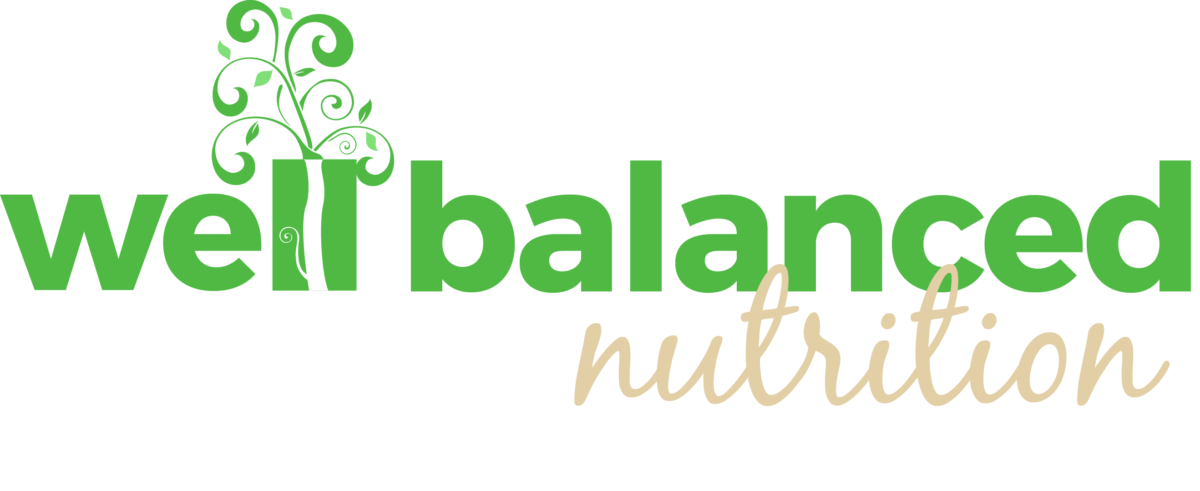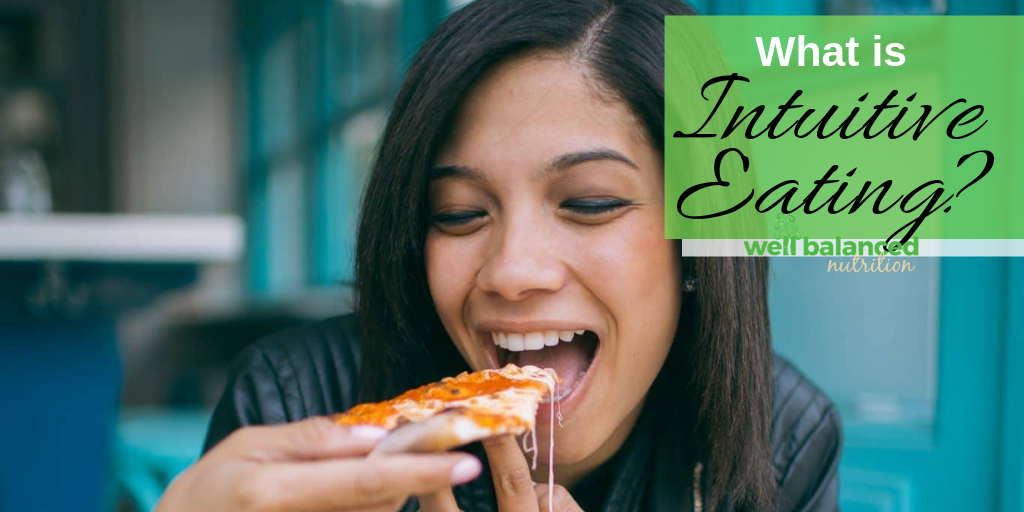
by Lucy | Apr 10, 2019 | Nutrition Questions Answered
It is an evidenced-based, mind-body philosophy comprised of 10 Principles and created by two dietitians, Evelyn Tribole and Elyse Resch in 1995. In Evelyn Tribole’s words, “Essentially, Intuitive Eating is a personal process of honoring health by listening and responding to the direct messages of the body in order to meet your physical and psychological needs. [This] includes physical activity for the sake of feeling good, rejecting the dieting mentality, using nutrition information without judgment, and respecting your body, regardless of how you feel about its shape.”
With intuitive eating, you call the shots.
Intuitive eating involves using your natural ability to be tuned into your mind and body. Only you know what hunger, fullness, and satisfaction feel like. Only you know your thoughts, feelings, and experiences. Therefore, as the expert of your own body, you may be empowered to call the shots about what, when and how much you eat.
Intuitive Eating is not a diet or food plan.
A dieter relies on outside cues and rules, whereas the intuitive eater relies on inner cues to eat as much or as little as they need. A dieter may label foods as bad or good, whereas intuitive eaters find a balance of choosing foods that feel good and foods that provide nutrition the body needs.
Will I lose weight if I use intuitive eating?
Some people will lose weight when they start to eat intuitively. Perhaps this is because when using intuitive eating they eat for emotional reasons less often and no longer have negative emotions around eating that can lead to overeating. However, intuitive eating is not designed for weight loss. It was designed as a weight-neutral approach. The goal of intuitive eating is gaining a healthy relationship with food and your body.
Why we like intuitive eating.
At Well Balanced Nutrition, we work with you to ditch the diet and become an intuitive eater. Diets do not lead to long term change, but paying attention to what your body needs, learning about nutrition, respecting your body, and implementing more self-care habits can leave you happier and healthier in the long term.
Ready to get off the diet roller coaster? You got this! Take the first step.
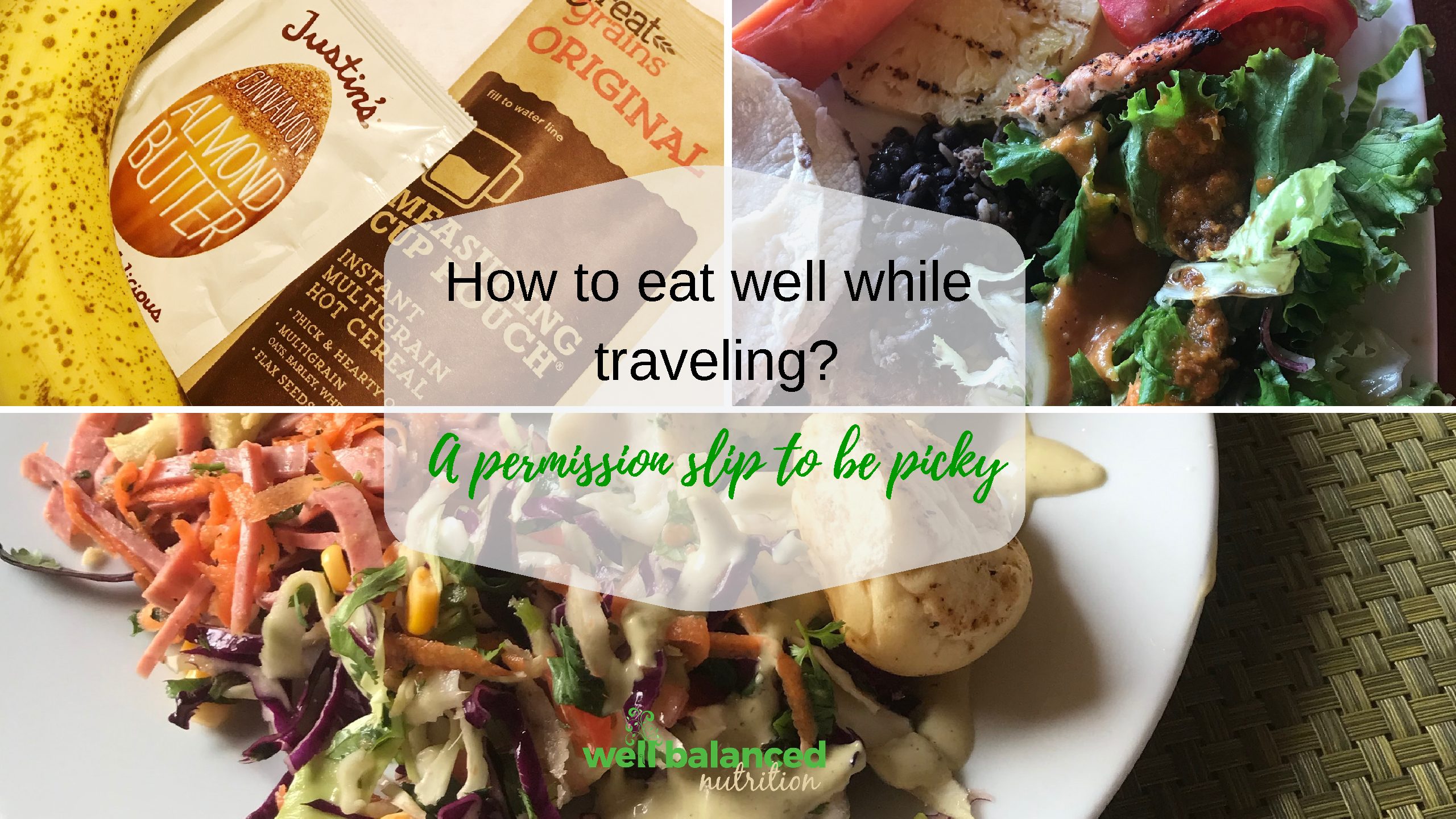
by Lucy | Feb 7, 2019 | Nutrition Questions Answered
Did you know approximately 1 in 5 of American’s have IBS and 40% of the population is living with a chronic condition?
This is a good reason to be nice to ourselves and nice to others because we don’t know what they are going through. It can be especially challenging to know how to eat well while traveling.
In January, Kristen and I went on our first international Well Balanced adventure to Costa Rica! It was an incredible trip coordinated by our new friend, Amanda Chay, with Wonderment. Needless to say, we had a lot of new experiences such as repelling down the side of the canyon into surprisingly cold water and discovering my new obsession with papaya!
As many of you know, I (Lucy), have been managing and coping with IBS for several years now. Click here to learn more. Anyway, whenever I travel, I get a little extra anxious around the lack of control regarding my food choices. In our small group of seven, we had 80% of the meals preplanned and catered to us. Normally, this sounds like a dream come true! However, when you have food sensitivities it can be more like a nightmare.
How I stay routine and regular
On our first morning in San Jose, Costa Rica, while I scooped up a small bowl of oatmeal my fiancé told our tour guide leader, Amanda, that oatmeal is a daily ritual of mine. She laughed and said, “well you can enjoy a break from that because I don’t have oatmeal on the menu for our breakfasts this week.” I laughed, I looked at Andrew and said, “isn’t she so funny?“ What Amanda did not know is I had packed six portable oatmeal packets and mini almond and peanut butter packets in order to continue my routine, which helps keep other things routine (*wink *wink).
So often, while talking about setting up healthy habits and sticking with them I hear clients say “but I don’t want to be picky or difficult.” For instance, if someone has a digestive and sinus issues they may greatly benefit by going dairy-free; however, when going to a friends house or out to eat they decide to just be polite and eat all the things despite knowing the negative effects of eating dairy products.
Change takes effort at first
Two years ago, when I did the big IBS elimination diet, I found my brain consumed thinking about “what am I going to eat at my next meal??” We’ve learned between 80 to 95% of everything we do is subconscious – think about last time you took a shower… did you think about every move you made? It takes time and energy to make conscious changes to our dietary choices, but it is possible. First, we must become aware of what and why we want to change. Then, we can make a plan and take action.
It doesn’t take that long to start feeling a little better and for your brain to pick up on new habits if you stay consistent. Some people will tell you it’s only 21 days; however, we learned from the book Better Than Before by Gretchen Rubin that on average new habits take about 66 days.
Your permission slip…
If you’re in the midst of making dietary and lifestyle changes or you already know what works for you, remember it’s OK to be picky and know that on occasion we might slip up and put cheese on the salad with ranch dressing because after all, we are human.
If you’re ready to feel better and determine which foods may be triggering inflammation and pain in your body, let’s chat.
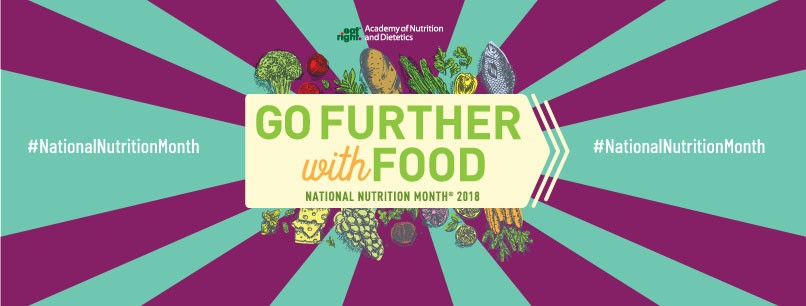
by Lucy | Mar 4, 2018 | Well Balanced Wisdom
Every March the Academy of Nutrition and Dietetics celebrates National Nutrition Month. The focus of NNM 2018 is Go Further with Food, which emphasizes the importance of making wise choices for your individual needs and reducing food waste by planning ahead.
Going further with food means meal planning, not meal plans.
Lucy and I often get requests for meal plans, and while we love to help you get Well-Balanced meals on the table, we feel strongly about helping you unleash your own meal planning powers. The key differences between meal planning and following a meal plan are flexibility, personal preference, and intuitive focus.
Flexibility
Meal plans can feel rigid. If you go off the plan you might feel like you are failing. Meal plans can’t possibly predict when you will have a long day at work or when a friend asks you to join her for dinner on a whim. They also don’t know what your budget is, what’s on sale or in season, or what’s currently in your kitchen.
Personal Preferences
Many things influence your food choices – from your culture and upbringing to your current mood. No generated or done-for-you meal plan is going to pinpoint exactly what sounds good this week or nail a plan that has you wanting to follow it to a T.
Intuitive Focus
Meal plans are often built around a calorie level or macronutrient goal but don’t allow room for intuitive choices. For instance, a meal plan doesn’t change on days when you need more fuel after an extra tough workout or your appetite is just not up-to-par for some reason or another. Only your body can tell you those things and if you are too concerned about following a plan – you could miss out on those important cues.
Don’t get me wrong, a meal plan created by someone else can be useful. It can give you inspiration or new meal ideas, a glimpse into what a Well-Balanced week could look like or get you started off on the right path. Ultimately, our goal for you is to be able to confidently make your own well-balanced plans and decisions that suit you. Plus allow for flexibility and intuitive eating.
In honor of National Nutrition Month, we will be sharing a series of posts centered around how to go further with food. We’ll cover ideas and strategies for having a plan, a backup plan, and knowing what to do if all else fails.
Food for thought: Do you plan ahead?
If you are highly organized and prepared in the kitchen this series is not for you. On the other hand, if you’ve struggled to stick to a meal plan or if you’re ready to start taking baby steps toward planning, you’ll find an idea below and more in the weeks to come.
Take the first step
If you typically don’t think ahead about what you will eat, you can start with this simple task. Take out a piece of paper while you are having your morning coffee and jot down what you will be having for dinner. Writing it down will solidify it and doing this in the morning while you are fresh will ensure you have plenty of mental stamina to make a wise decision. Once you get the hang of it, perhaps you can decide on more than one meal at a time, but for now, just focus on dinner for the upcoming evening.
Happy planning!
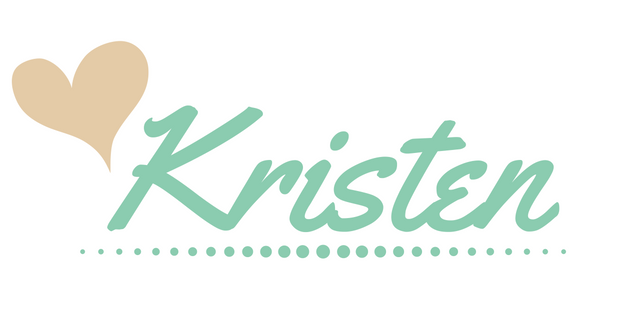
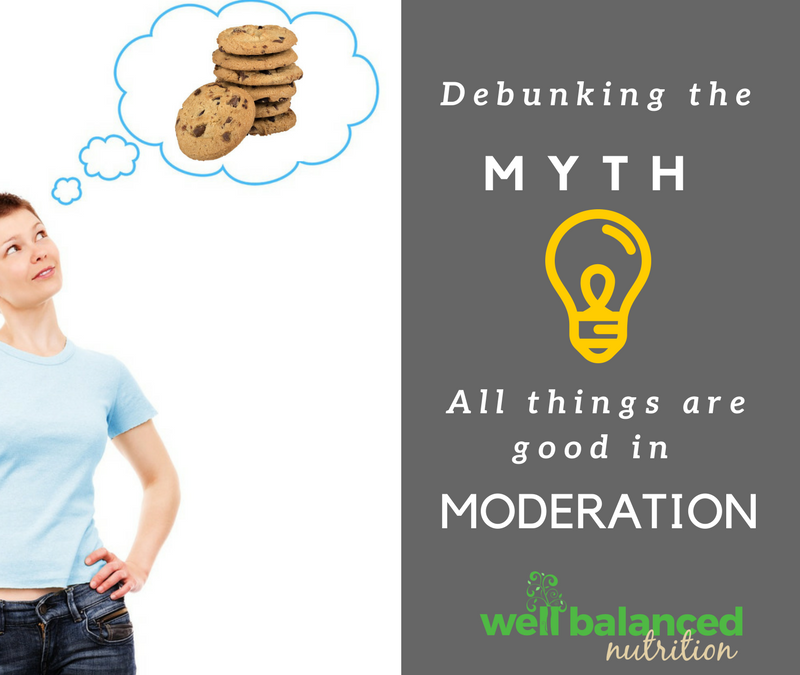
by Lucy | Jan 21, 2018 | Well Balanced Wisdom
Monday, January 22, 2018
Ever catch yourself thinking “oh I shouldn’t…” or I just can’t have one [insert food with no brakes]. Yep, we’ve all been there. It varies depending on a person’s taste preference and often what they grew up eating. A few I hear commonly include, potato chips, cashews, ice cream, cheese, or bite-sized Oreos. No matter what, there are certain foods that are just harder to eat in moderation.
Last year, Kristen and I read a great book called
Better Than Before by Gretchen Rubin in our book club. The book is all about making better habits. In an article, by Rubin, she talks about the concept modernization and abstinence. Some of you (like me), may already be rolling your eyes because the idea of abstaining from any food sounds terrible. That likely means you are a moderation all-star!
The snow day cookies
A friend of mine was recently telling me a story about moderation. She explained after eating a homemade chocolate chip cookie at work, “my tummy and my mouth were arguing,” because her mouth wanted another cookie but her stomach felt full. My friend goes on to tell me about the sweet, chewy, chocolatey goodness of the homemade cookies. She reports savoring each bite only to find herself still wanting more when she was done. This is a familiar experience for many of us; however, it is rare that this happens after eating celery or an apple. What’s that about?!
Effects of sugar on the brain
It’s scientifically explained, in this fascinating TED education video:
How sugar affects the brain. When we eat foods with refined sugar or simple carbohydrates (think white rice, pasta, potatoes, etc), those foods create a chemical release (dopamine) that feels good and may lead our brain to tell us to eat more. Our brain is designed to keep us alive and in case there is a famine, it will ensure we “stock up” when energy-dense foods are available.
Empowering abstinence
At the beginning of the year, Well-Balanced Nutrition did a 2-week challenge to eat only from the
Well-Balanced plate, which does not include added sugars. Our plate does include fruits, vegetables, complex carbohydrates, and dairy, which all provide the energy our brains need. For me, this was an experiment to break the habit of always wanting a treat after lunch and dinner. What I didn’t expect was to feel empowered by choosing to abstain from added sugars. It is exhausting to constantly battle that voice “should I eat the cookie or shouldn’t I?” It was nice to have the decision already made when I chose to take a break from processed sugar.
Food for thought:
In the challenge, I learned, not all foods are good in moderation. Some foods create a trigger that makes it hard to stop even if I’m not hungry anymore.
What are your triggers? If you’d like to become a more balanced eater, we recommend starting to recognize what foods or situations cause you to overeat.
If you’d like to talk with a friendly expert on making (and breaking) habits, let us know.
Contact us here.

by Lucy | Dec 18, 2017 | Well Balanced Wisdom
Monday, Dec 18, 2017
But it’s a holiday! Birthday! Vacation! Or we’re celebrating! The fact is, there is always a good excuse to eat unbalanced food – especially sugar.
As we wrap up another year and holiday season, it is a good opportunity to press the reset button and take a closer look at our eating habits. Hopefully, you have been practicing
mindful and intuitive eating this season and enjoying every morsel of those special holiday foods. Of course, when there are more celebrations around the corner it’s hard to stay balanced at each meal. Also, if you and the family found yourselves constantly on-the-go these past few weeks that may mean more fast food and less time to cook.
Let’s refocus and refresh
Step 1: Get honest with yourself. Ask yourself, “How much added-sugar do I really eat?”
Sometimes, it’s hard to tell. Maybe there’s a little bit of honey in your morning oats. A little added sugar in the salad dressing at lunch. A little more sugar in the bread of the half sandwich you ate with the salad. A little bit in the afternoon granola bar. Even if you don’t consider yourself “a sweet-tooth person“ you could be taking in more sugar than you realize. Sugar enhances the flavor of foods and entices our taste buds to keep eating. That is one reason why food manufacturers keep adding it to so many of our favorite things. Especially, as the nation went to
low-fat or non-fat foods our pallets compromised by enjoying more sugar. Now we know,
fat is our friend.
Important to note, at Well-Balanced Nutrition, we do not treat sugar as the enemy. The goal is to identify where sugar is sneaking into your diet so you can mindfully choose to eat it or leave it alone. This gives our taste buds the chance to reset and notice the natural sweetness of fruits, vegetables, cream (instead of sugar in the coffee), and even some whole grains such as oats are naturally sweet.
Step 2: Clean it out.
If you decide to join our Well-Balanced Challenge and no sugar added journey we want to provide the parameters of success. In order to succeed, we need to
clean out the cupboards and
fridge of those foods that have added sugar. If you cannot bear to toss it out at least move everything out of reach. Perhaps putting foods into a concealed bag and a hard to reach cupboard. This step is crucial for your success. Many of us try to depend on willpower, only to later experience the call of the sugar monster at those unexpected hours of the day and night. By eliminating the temptations from your office and kitchen you can then fill in with lots of yummy natural foods that provide the fuel your body and mind needs. There’s even a 2-week meal plan to guide you on the journey!

